Disaccharides Study guides, Class notes & Summaries
Looking for the best study guides, study notes and summaries about Disaccharides? On this page you'll find 2260 study documents about Disaccharides.
Page 4 out of 2.260 results
Sort by
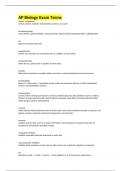
-
AP Biology Exam Terms
- Exam (elaborations) • 23 pages • 2024
-
- $11.59
- + learn more
AP Biology Exam Terms organic compounds contain carbon; examples include lipids, proteins, and carbs functional groups amino (NH2), carbonyl (RCOR), carboxyl (COOH), hydroxyl (OH), phosphate (PO4), sulfhydryl (SH) fat glycerol and three fatty acids saturated fats bad for you; animals and some plants have it; solidifies at room temp. unsaturated fats better for you, plants have it; liquifies at room temp. steriods lipids whose structures resemble chicken-wire fence...

-
ATI Nutrition Exam Study Guide Notes: Guaranteed A+ Guide Solution
- Other • 16 pages • 2023
- Available in package deal
-
- $8.00
- + learn more
ATI SOURCES OF NUTRITION CHAPTER 1 o Carbs: energy for the body 130g/day 45%-65% of calories Monosaccharides: glucose (corn syrup), fructose (fruits), galactose (in milk) Basic energy for cells Disaccharides: sucrose (table syrup), lactose (milk sugar, maltose (malt sugar) Energy Polysaccharides: starches (grains, legumes, root veggies, fiber (whole grains, fruits, veggies) Energy, storage/digestive aid: ATI NUTRITION INGESTION, DIGESTION, ABSORPTION, M...

-
NSC Exam 2 | 100% Correct Answers | Verified | Latest 2024 Version
- Exam (elaborations) • 12 pages • 2024
- Available in package deal
-
- $10.49
- + learn more
list the disaccharides in alphabetical order - lactose. maltose, sucrose Carbohydrates are the first link in the food chain and are obtained almost exclusively from ________ . Through _________________ , plants combine carbon dioxide, water, and the sun's energy to form _____________ , from which the human body can obtain energy. Carbohydrates are made of carbon, hydrogen, and ____________ . - plants, photosynthesis, glucose, oxygen list the monosaccharides in alphabetical order - fruct...
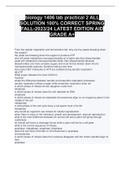
-
biology 1406 lab practical 2 ALL SOLUTION 100% CORRECT SPRING FALL-2023/24 LATEST EDITION AID GRADE A+
- Exam (elaborations) • 4 pages • 2023
-
- $15.99
- 1x sold
- + learn more
From the cellular respiration and fermentation lab, why are the yeasts breaking down the sugars? the yeast are breaking down the sugars to produce ATP why will yeast metabolize monosaccharaides at a faster rate than disaccharides yeast will metabolize monosaccharides faster than dissacharides because dissacharides are more complex sugars and must first be broken down into its monosaccharide subunits, therefore taking more time how many NET molecules of ATP are created during aerobic respi...
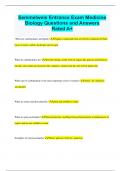
-
Semmelweis Entrance Exam Medicine Biology Questions and Answers Rated A+
- Exam (elaborations) • 26 pages • 2024
- Available in package deal
-
- $9.99
- + learn more
Semmelweis Entrance Exam Medicine Biology Questions and Answers Rated A+ What are carbohydrates and lipids? Organic compounds that are mostly composed of three types of atom; carbon, hydrogen and oxygen What do carbohydrates do? provide energy, in the form of sugars like glucose and fructose, but they also make up structures like cellulose, which form the cell wall of plant cells What type of carbohydrate is the most important source of energy? mono-, di- and poly- saccharides ...
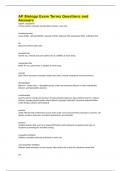
-
AP Biology Exam Terms Questions and Answers
- Exam (elaborations) • 23 pages • 2024
-
- $10.89
- + learn more
AP Biology Exam Terms Questions and Answers organic compounds contain carbon; examples include lipids, proteins, and carbs functional groups amino (NH2), carbonyl (RCOR), carboxyl (COOH), hydroxyl (OH), phosphate (PO4), sulfhydryl (SH) fat glycerol and three fatty acids saturated fats bad for you; animals and some plants have it; solidifies at room temp. unsaturated fats better for you, plants have it; liquifies at room temp. steriods lipids whose structures resem...

-
NUR231 MCQ Exam Review Exam Questions With 1005 Correct Answers
- Exam (elaborations) • 37 pages • 2024
-
- $14.59
- + learn more
NUR231 MCQ Exam Review Exam Questions With 1005 Correct Answers A chemical bond in which electrons are equally shared is a(n) a. Ionic bond b. Polar covalent bond c. Nonpolar covalent bond d. Hydrogen bond c. Nonpolar covalent bond The bond of oxygen and hydrogen between water molecules is a a. Ionic bond b. Polar covalent bond c. Nonpolar covalent bond d. Hydrogen bond b. Polar covalent bond The unit molecules (monomers) of carbohydrates are a. Monosaccharides b. ...

-
FINAL EXAM (BIOD 121) QUESTIONS AND ANSWERS 2023-2024
- Exam (elaborations) • 58 pages • 2023
- Available in package deal
-
- $17.99
- + learn more
FINAL EXAM (BIOD 121) QUESTIONS AND ANSWERS What is the difference between hunger and appetite? - CORRECT ANSWER-Hunger: Internal drive that prompts negative sensations for us to find food and eat Appetite: External drive that is a positive sensation; a desire to consume specific foods. List two examples of Cognitive external forces that can influence eating habits and comment on your personal experience with each of them. - CORRECT ANSWER-Habits, Comfort foods, Advertising, Social ...

-
EXS 397 Test 1 Questions & Answers 2024/2025
- Exam (elaborations) • 14 pages • 2024
- Available in package deal
-
- $8.99
- + learn more
EXS 397 Test 1 Questions & Answers 2024/2025 Monosaccharides - ANSWERS• Basic unit of carbohydrates • Glucose (C6H12O6) Produced in body through digestion • Uses: Energy for the cell Stored as glycogen in muscles and liver Converted to fats for energy storage Fructose - ANSWERS- sweetest of monosac.; some absorbed directly into blood Galactose - ANSWERS- forms lactose in mammary glands; can convert to glucose Disaccharides - ANSWERSMonosaccharide + Monosaccharide ...
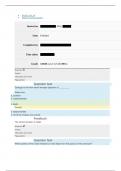
-
BIO202 exam3 Topic 9: Urinary System Straighterline SPRING 2024
- Exam (elaborations) • 12 pages • 2024
-
- $23.49
- + learn more
Question 1 Correct 5.00 points out of 5.00 Flag question Question text Damage to the liver would hamper digestion of_________. Select one: a. proteins b. carbohydrates c. lipids Correct d. disaccharides e. All of the choices are correct. Feedback The correct answer is: lipids Question 2 Correct 5.00 points out of 5.00 Flag question Question text Which portion of the small intestine is most distal from the pylorus of the stomach? Select one: a. Duodenum b. Jejunum c. Hepat...

Do you wonder why so many students wear nice clothes, have money to spare and enjoy tons of free time? Well, they sell on Stuvia! Imagine your study notes being downloaded a dozen times for $15 each. Every. Single. Day. Discover all about earning on Stuvia


